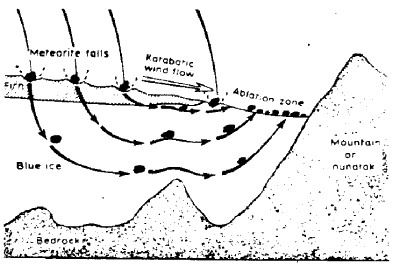 |
Science Frontiers ONLINE No. 27: May-Jun 1983 |
|
|
The solar-system dust bin
For hundreds of thousands of years, miscellaneous rocky debris swirling around the sun has been falling upon the icy wastes of Antarctica. The motion of Antarctica's ice sheet carries these meteorites conveyor-belt fashion out towards the encircling seas. But where Antarctic mountains get in the way, the rocky cargo tends to get concentrated. Several thousand meteorites have already been picked up at these favored spots. In just a few brief summers of searching, these massive finds have posed unexpected questions. Here is a sampling.
- The terrestrial ages (times since arrival on earth) measure between 1,000 and 700,000 years, implying that the Antarctic ice sheet may be at least 700,000 years old. This is unfortunate for several proposed scenarios of recent catastrophism, which envision an iceless Antarctica.
- At least 20 amino acids appear in the more than 40 carbonaceous chondrites picked up with sterile equipment. These meteorites are dated as 4.5 billion years old, or 1 billion years older than the earliest terrestrial life found in the rocks. These finds highlight the old question: Did meteorites seed life on earth?
- The much-publicized "lunar" meteorite, supposedly blasted out of the moon's crust by asteroid impact, thence falling to earth, shows little evidence of mechanical shock. If this meteorite, with a composition so similar to the Apollo samples is not from the moon, where did it come from?
(Marvin, Ursula B.; "Extraterrestrials Have Landed on Antarctica," New Scientist, 97:710, 1983.)
